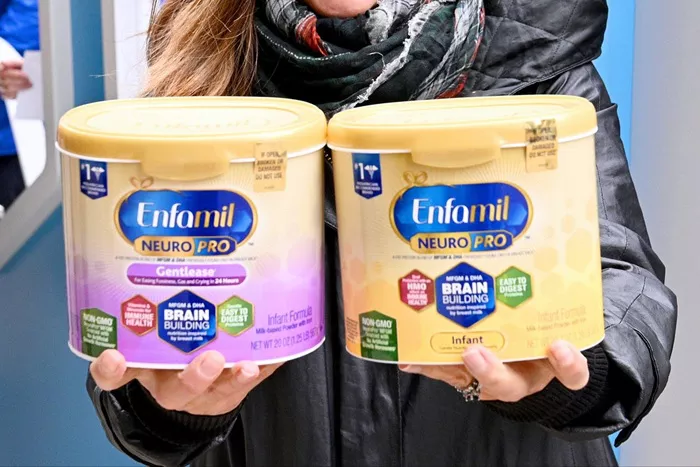Many parents rely on baby formula as a primary source of nutrition for their infants. According to the Centers for Disease Control and Prevention (CDC), by six months, about 75% of babies are given formula in addition to breast milk.
Formula feeding is often seen as a convenient and reliable option, especially for parents who cannot or choose not to breastfeed. It also offers flexibility, ensuring babies are fed consistently even when parents are away.
However, a new study from Consumer Reports (CR) has raised concerns. The investigation tested 41 different baby formulas and found that some contained “worrying levels of contaminants” such as arsenic, lead, PFAS, BPA, and acrylamide.
Sana Mujahid, manager of CR’s food safety and research, explained that contamination likely occurs either during the manufacturing process or due to contaminated ingredients. These findings are part of a broader issue, as previous reports have identified dangerous contaminants in other baby products, such as cereals and snacks.
Vulnerable Infants at Risk
Infants are particularly vulnerable to the harmful effects of these contaminants, as formula is often their sole source of nutrition.
“We’ve known for a while that arsenic and lead can show up in baby formula, but what’s frustrating is that while some formulas manage to keep these levels low, others do not,” said Dr. Phil Boucher, a pediatrician based in Lincoln, Nebraska.
He specifically mentioned PFAS, chemicals commonly found in food, water, and soil. While not surprised to see PFAS in some formulas, Dr. Boucher is concerned that nearly all the formulas tested by CR contained detectable amounts of PFAS. “This shows that more oversight is needed on how these chemicals are entering the food supply,” he added.
Health Risks of Contaminants
High levels of contaminants pose various health risks, especially for babies. The U.S. Food and Drug Administration (FDA) warns that exposure to high arsenic levels can lead to neurological issues, such as learning disabilities and lower IQs, particularly in children. Lead exposure in infancy can also result in developmental delays and behavioral problems.
The U.S. Environmental Protection Agency (EPA) highlights the dangers of PFAS, linking them to reproductive harm, developmental issues, cancer, immune system disruption, and hormone imbalance. Meanwhile, BPA, a known endocrine disruptor, has been associated with infertility, early puberty, and various cancers.
Which Formulas Had the Most Contaminants?
CR tested a mix of popular and lesser-known brands, including Enfamil, Similac, and newer market entrants. The formulas were sorted into categories: “Top Choices,” “Good Choices,” and “Worse Choices.”
While most formulas tested showed low or no levels of contaminants, some formulas raised red flags. Products from brands like Dr. Brown’s, Enfamil, Kabrita, and Similac contained concerning amounts of contaminants, with lead being the most commonly detected.
CR reached out to the companies involved, including Abbott Nutrition and Mead Johnson, who maintain that their products are tested to ensure they meet safety standards. They also noted that heavy metals are present in the broader food supply, not just in baby formulas.
FDA’s Response and New Oversight
In response to ongoing concerns, the FDA announced “Operation Stork Speed” on March 18, 2025. The initiative aims to enhance oversight of the domestic infant formula supply to ensure quality, safety, and nutritional adequacy.
What Parents Can Do
If your baby’s formula is on the “Worse Choices” list, Dr. Boucher advises switching to a different brand. However, he stresses that parents should consult their child’s healthcare provider before making any changes.
For parents who have used potentially contaminated formulas for extended periods, Dr. Boucher suggests checking for lead exposure with a simple blood test. Many pediatricians screen for lead at 12 and 24 months. Testing for other contaminants like arsenic and PFAS is not typically done on an individual basis, though blood, urine, or hair samples can detect heavy metals if there is a reason to suspect exposure.
The Dangers of Homemade Formula
In light of these findings, Consumer Reports warns against making homemade baby formula. Dr. Boucher emphasizes that babies have specific nutritional needs, and even slight mistakes in nutrient balance can lead to serious health problems, including organ failure.
Rebekah Diamond, MD, a pediatrician at Columbia University, echoed this caution. “The wrong mix of electrolytes can cause dangerous imbalances, such as hyponatremia, which can lead to seizures or be fatal.”
Both experts stress that ensuring formula is safe and properly regulated is crucial, as homemade recipes are prone to contamination and nutritional imbalances.
Conclusion
While the findings from Consumer Reports are concerning, the research aims to empower parents to make safer choices. Parents are urged to remain vigilant and consult healthcare professionals if they have concerns about their baby’s formula.
Related Topics:


